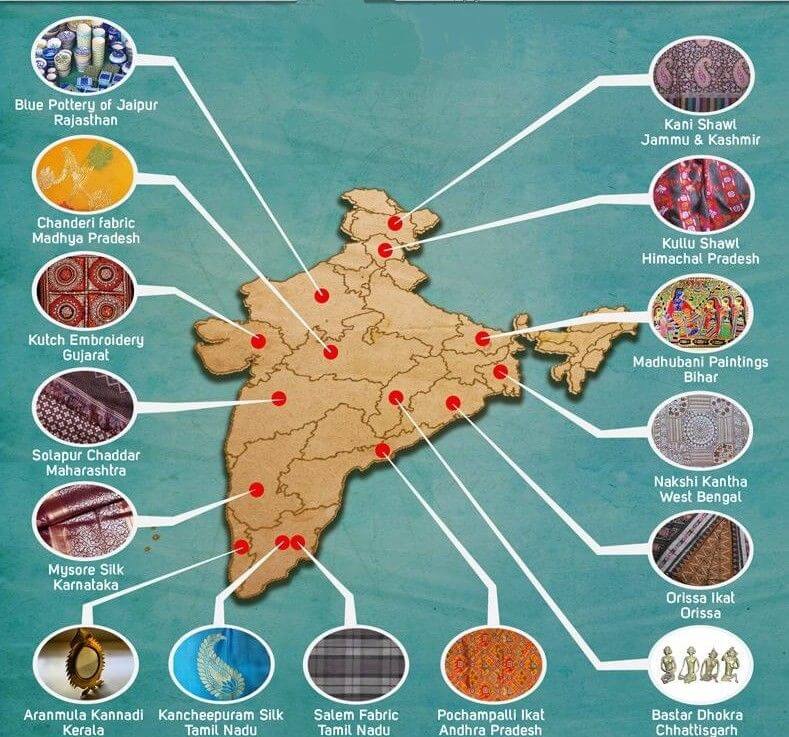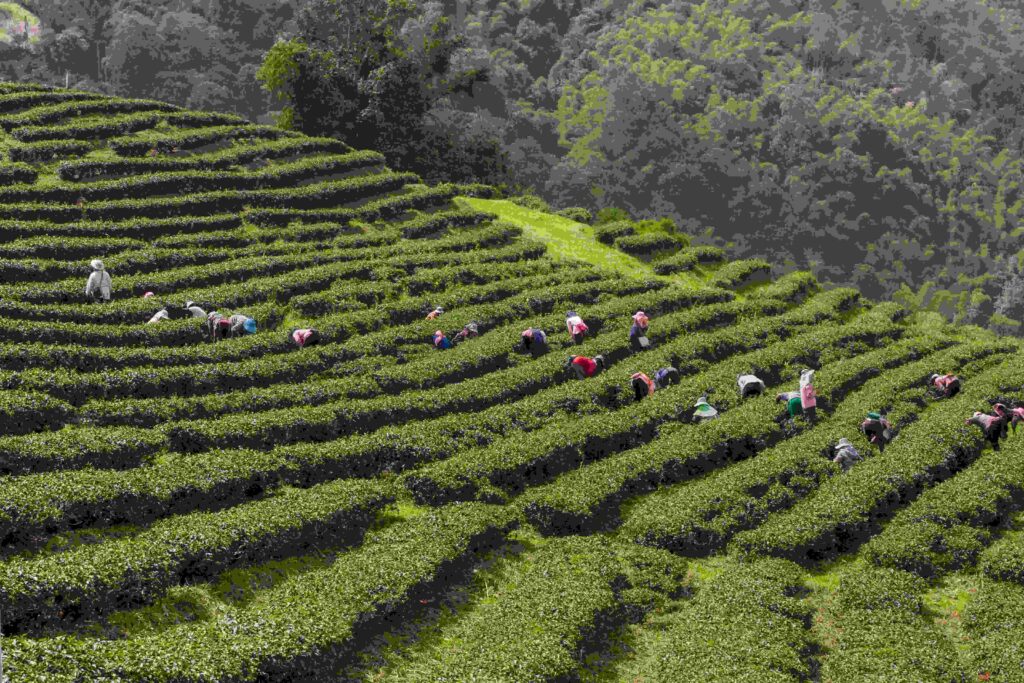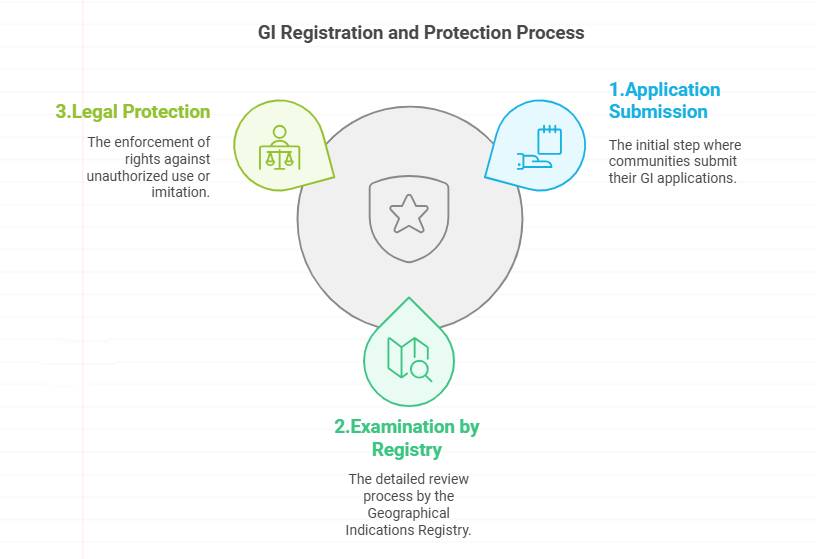In an era characterized by rapid environmental deterioration, the link between intellectual property rights and ecological sustainability is being increasingly acknowledged. The concept of Geographical Indications (GIs) is a promising tool at this junction. GIs link products not only to the development of local communities but also to the preservation of cultural heritage and conservation of natural resources. GIs have the potential to protect indigenous communities’ intellectual heritage and cultural identity from misuse and commercialization, promoting long-term development, particularly in rural areas. GIs play a dual role, empowering rural communities economically while also preserving the authentic cultural and ecological aspects of their products. This serves as a catalyst for sustainable development in the local community and surrounding area. To better understand their role in sustainable development, it is essential to explore what Geographical Indications are and how they function within the intellectual property rights framework.
Understanding GIs


Geographical Indications are a strategic tool for adding value to products. They are categorised under the Intellectual Property Rights (IPRs) framework. The Intellectual Property Rights (IPRs) are legal protections given to ideas that are developed into technologies or concrete expressions. The various categories of IPRs are: patents (for inventions), trademarks (for goods and services), copyrights (for literary and artistic works), industrial designs (for the ornamental or aesthetic aspects of articles), trade secrets (for protection of confidential business information), and geographical indications (GIs). These categories serve as mechanisms to protect ideas under the umbrella of Intellectual Property Rights. These rights recognize and legally safeguard the intangible creations of the human mind, emphasizing their territorial application and broader socio-economic impact.
Geographical Indications are collective rights, typically held by a community or group of producers. These rights are aimed at protecting products that derive their distinct qualities, reputation or other characteristics from a specific geographical origin. GIs not only help maintain product authenticity but also play a vital role in preserving traditional practices, supporting rural livelihoods and enhancing marketability. Examples include Makrana marble, indigenous to Rajasthan, and Banarasi sarees, renowned for their traditional craftsmanship originating in Varanasi. The French sparkling wine from the Champagne region, called the ‘Champagne’, is also a well-known GI. Beyond their role in intellectual property protection, GIs have significant implications for economic, environmental, and cultural sustainability.
Role of Geographical Indications in Supporting Sustainable Development
This multifaceted nature of GIs extends far beyond basic intellectual property protection, positioning them as powerful instruments for sustainable development. Their legal recognition under international frameworks provides the foundation for their broader socio-economic impact. One of the key binding international agreements is Trade-Related Aspects of Intellectual Property Rights (TRIPS), administered by the World Trade Organization (WTO) TRIPS provides protection for the intellectual properties, including geographical indications. Article 22.1 of the agreement defines GIs as: “indications which identify a good as originating in the territory of a member, or a region or locality in that territory, where a given quality, reputation or other characteristic of the good is essentially attributable to its geographical origin.”(TRIPS, WTO)

GIs contribute to sustainable development in different ways- economic, environmental, social and cultural. Economically, GIs increase the market value of the local products highlighting their unique qualities and origins. This helps producers, especially small-scale and rural communities, earn better incomes and access niche markets. Environmentally, GI products are closely linked to specific ecosystems. This connection promotes the preservation of biodiversity and natural habitats, as the production processes are typically adapted to the local environment. Socially and culturally, GIs play a vital role in preservation of traditional knowledge and skills. By recognising and rewarding indigenous and local producers, GIs foster inclusive growth and protect cultural heritage.
Moreover, GIs encourage resource stewardship through the ownership of product rights. A notable example is the Chanderi weavers of India. After obtaining GI registration, these artisans began enforcing quality standards and preservation of authentic weaving techniques, thereby preventing market dilution from machine-made imitations. GIs also promote ethical and transparent trade. They enhance traceability and ensure authenticity, which protects both producers and consumers from unfair competition and misleading information, respectively.
Beyond the economic and cultural benefits, GIs support the long-term development of rural regions in three key areas: economic growth, social cohesion and environmental sustainability. GIs can promote local economies by stimulating tourism, creating employment opportunities and improving producers’ income. This economic empowerment leads to more resilient communities by enhancing their capacity to sustain livelihoods. As a result, GIs promote social cohesion and identity within a society by bringing together various recognized units to demonstrate their differences. In terms of the environment, emphasis is placed on traditional GI practices alongside the promotion of sustainable agricultural methods that preserve the environment and also enhance product quality. GI studies help individuals realize how rural communities may maintain their identity and sustainability.
GI serves as an important bridge between traditional knowledge systems (TKS), sustainable agriculture, and local economy. They link individual products to geographical locations of production, directly correlating regional culture, the environment, and traditional production processes. Local product promotion through GIs contribute to growth and development of rural regions, while also preserving cultural identity and promoting sustainable development.
GI Application and Documentation

While the sustainable development benefits of GIs are compelling, transforming these conservation advantages into reality requires navigating India’s comprehensive legal framework. India implemented a sui-generis system of GI protection with the Geographical Indications of Goods (Registration & Protection) Act 1999 (GI Act) and GI Rules 2002. The GI Act establishes a registration mechanism, with registration serving as prima facie evidence of validity. Although the initial registration is valid for 10 years, it can be renewed. A GI can be registered under various categories of commodities. For example, ”Pochampally Ikat” has been registered in three classes: 24, 25, and 27. Only one application may be filed for the registration of a GI for multiple classes of products, with a separate fee required for each product class. The right to a registered Geographical Indication (GI) is non-transferable; it cannot be assigned, licensed, transmitted, pledged, mortgaged, or otherwise transferred. Moreover, generic names are not eligible for registration under the GI Act. A geographical indication also cannot be registered as a trademark, as both forms of protection serve distinct legal functions.
Moving forward, it is important to understand that GI registration is more than just a legal formality. It also requires detailed documentation of the product’s traditional knowledge, environmental conditions and methods of production. These often reflect eco-friendly and resource-efficient practices. For example, Sundarban Honey is collected using non-invasive techniques in the world’s largest mangrove forest. Its distinctive qualities are closely linked to the floral diversity of the mangroves. This demonstrates how the GI framework inherently supports ecosystem preservation.
By emphasizing the link between local ecosystems and product quality, the GI framework not only promotes environmental sustainability but also drives economic value. When products receive GI recognition, their market appeal increases, offering communities a financial incentive to preserve traditional methods and manage natural resources responsibly. This blend of cultural heritage and commercial value encourages sustainable practices.
Challenges in Implementing Geographical Indications for Conservation
Despite their significant potential as conservation tools, Geographical Indications (GIs) face substantial implementation barriers that limit their effectiveness in protecting natural resources and supporting rural communities.
The most fundamental challenge lies in the disconnect between traditional practice and modern intellectual property concepts. Rural communities often have traditional products and knowledge specific to their territories, yet many artisans and producers remain unaware of GI frameworks or how their ancestral practices could benefit from formal protection.
This knowledge gap is compounded by the complexity of GI registration procedures, which present significant hurdles for rural communities. Current systems often require extensive documentation, legal expertise, and administrative capacity that many traditional producers lack. Additionally, enforcement mechanisms remain weak in many regions, undermining the value of GI protection even when successfully obtained.
Beyond procedural barriers, market development represents another significant challenge. Traditional products often struggle to reach consumers who appreciate their unique qualities and conservation value. Compounding these market difficulties, ensuring equitable benefit distribution remains a persistent problem. Intermediaries and larger enterprises often capture disproportionate value from GI products, while traditional knowledge holders receive minimal compensation. This inequitable distribution undermines the conservation incentives that GIs are designed to create.
Overcoming these barriers requires coordinated action through targeted capacity building and streamlined procedures. Developing simplified educational materials and awareness programs can bridge the knowledge gap, while government agencies must simplify registration processes through technical support centres and user-friendly guides.
Equally important are market development and governance reforms. Collaborative marketing initiatives, digital marketplaces, and public-private partnerships can help traditional products reach appropriate consumers while sharing promotional costs. Establishing transparent benefit-sharing mechanisms ensures that conservation incentives reach traditional knowledge holders directly, creating sustainable pathways for both environmental protection and rural development.
Conclusion
Geographical Indications represent a sophisticated intersection of intellectual property rights, sustainable development and natural resource conservation. This article reveals how GIs function as strategic tools that simultaneously protect traditional knowledge, empower rural communities economically and incentivize environmental stewardship. By linking products to their geographical origins and traditional production methods, GIs create economic value while preserving biodiversity, protecting ecosystems, and maintaining cultural heritage.
GIs drive sustainable development through three key dimensions: economically by connecting rural communities to premium markets, environmentally by protecting traditional sustainable practices, and socially by preserving indigenous knowledge and community identity. Examples like Chanderi weaving and Sundarban honey demonstrate how GI recognition transforms communities into active conservation stakeholders.
The success of GIs as conservation tools ultimately depends on transforming them from legal instruments into living systems that empower communities to become guardians of their natural and cultural heritage. When properly implemented, GIs offer a rare opportunity to achieve what often seems impossible: economic development that strengthens rather than depletes natural resources, creating a model where development and conservation are mutually reinforcing.
REFERENCES
Das, K. (2010). Prospects and challenges of geographical indications in India. The Journal of World Intellectual Property, 13(2), 148-201.
Md Tanweer Alam Sunny, et al (2024), Geographical Indications as Tools for Sustainable Development in Rural Areas, Educational Administration: Theory and Practice, 30(1), 5504-5511 Doi: 10.53555/kuey.v30i1.9064
World Trade Organization. (1994). Agreement on Trade-Related Aspects of Intellectual Property Rights (TRIPS), Part II, Section 3: Geographical Indications. In The legal texts: The results of the Uruguay Round of multilateral trade negotiations (pp. 328–335). Cambridge University Press. https://www.wto.org/english/docs_e/legal_e/27-trips_04b_e.htm

